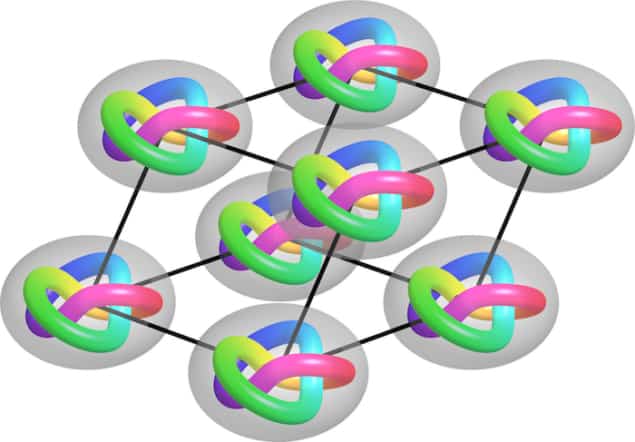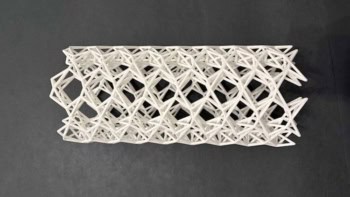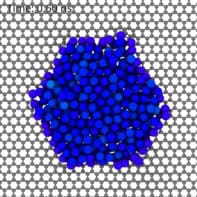
Molecular self-assembly can produce stable 3D knots in chiral liquid crystals. The knots, which have been dubbed heliknotons by the researchers who discovered them, have particle-like properties and are microns in size. Their shape can be controlled using low-voltage applied fields, which means they could be transformed into highly functionalized materials for use in a host of technology applications, including electro-optical devices, microfluidics and actuators. If found in other chiral material systems, such as solid-state chiral magnets or even light fields, applications in spintronics and optical computing might also be possible.
Topological physics has been undergoing somewhat of a renaissance in recent years, but this field has a long history going back to the Victorian era. Carl Friedrich Gauss postulated, for example, that knots in a field could behave like particles, while Lord Kelvin and his contemporaries Peter Guthrie Tait and James Clerk Maxwell believed that matter could be made of real-space free-standing knots of vortices. What was surprising in these early days was that these models were introduced long before researchers had widely accepted the very existence of atoms.
In more recent years, physicists, including Tony Skyrme (for whom skyrmions are named), have modelled subatomic particles with different baryon numbers as non-singular topological solitons and their clusters. Quantum field theories, fluid mechanics and particle physics and cosmology also postulate the existence of knotted fields. And that is not all: condensed matter researchers have found that arrays of singular vortex lines and analogies of Skyrme solitons are important building blocks in exotic thermodynamic phases in superconductors, magnets and liquid crystals. Most of these knotted fields are however unstable or unable to self-organize into 3D lattices.
Energetically stable, micron-sized topological knots
A team led by Ivan Smalyukh and Jung-Shen Benny Tai of the University of Colorado at Boulder in the US are now reporting on energetically stable, micron-sized topological knots in chiral liquid crystals that behave like knotted vortices and non-singular soliton knots. These “heliknotons” indeed behave like particles in that they show 3D Brownian motion and self-assemble into 3D crystals.
The researchers observed the structures in commercially available liquid crystals doped with chiral molecules that caused all the molecules to rotate like a corkscrew along the helical axis.By applying an electric field, they created vortex lines, which spontaneously tied themselves into knots in a helical background.
“It is as if the molecules know how to tie a knot and self-assemble into these structures themselves,” explains Smalyukh. “They also know how to then self-assemble 3D crystals from many such knots. Thanks to numerical analyses, we found that these knots are favourable for the material since they lower the total energy of the system.”
The team says it used precision laser tweezers to move these knots around. The knots self-assemble into either 2D or 3D lattices with open or closed structures (such as the Kagome lattice), but they only form the types of crystals that minimize the liquid crystal’s free energy.
Different topologies
“The knots we demonstrate in our work have different topologies that manifest as the crossing, or linking, number,” adds Smalyukh. “By choosing different material parameters, such as sample thickness and applied field strength, diverse types of knots can emerge.
“One important property of these structure is that they are topologically distinct – you can’t smoothly morph from one to another without tearing the continuum of the field. This proves that they are topologically protected.”
This topological protection makes them good candidates for use as information carriers, he tells Physics World. “As with liquid crystals, which are widely employed in displays and can be switched from one state to another by a low voltage, so these knots also strongly respond to applied electric fields, switching between different chiral versions, synclinic- and anticlinic-tilted, of self-assembled crystals of knots in the lattice.”

Negative order appears in liquid crystals
Giant electrostriction
“The shape and size of these knots and their crystals also show giant electrostriction – that is, their shape and size dramatically change with applied field – a phenomenon that might be exploited in electro-optics devices, for example,” he adds. “This giant electrostriction, together with their facile response and optical properties, could also enable applications in microfluidics and actuator devices.”
The new type of stable knotted field in liquid crystals demonstrated by Smalyukh, Tai and colleagues is of fundamental importance for mathematicians and physicists and it might even appear in materials other than liquid crystals, says Smalyukh. “We are highly confident that this is the case and have begun to look for these structures in chiral material systems, such as solid-state chiral magnets and even light fields.”
Full details of the research are reported in Science 10.1126/science.aaz0479.



